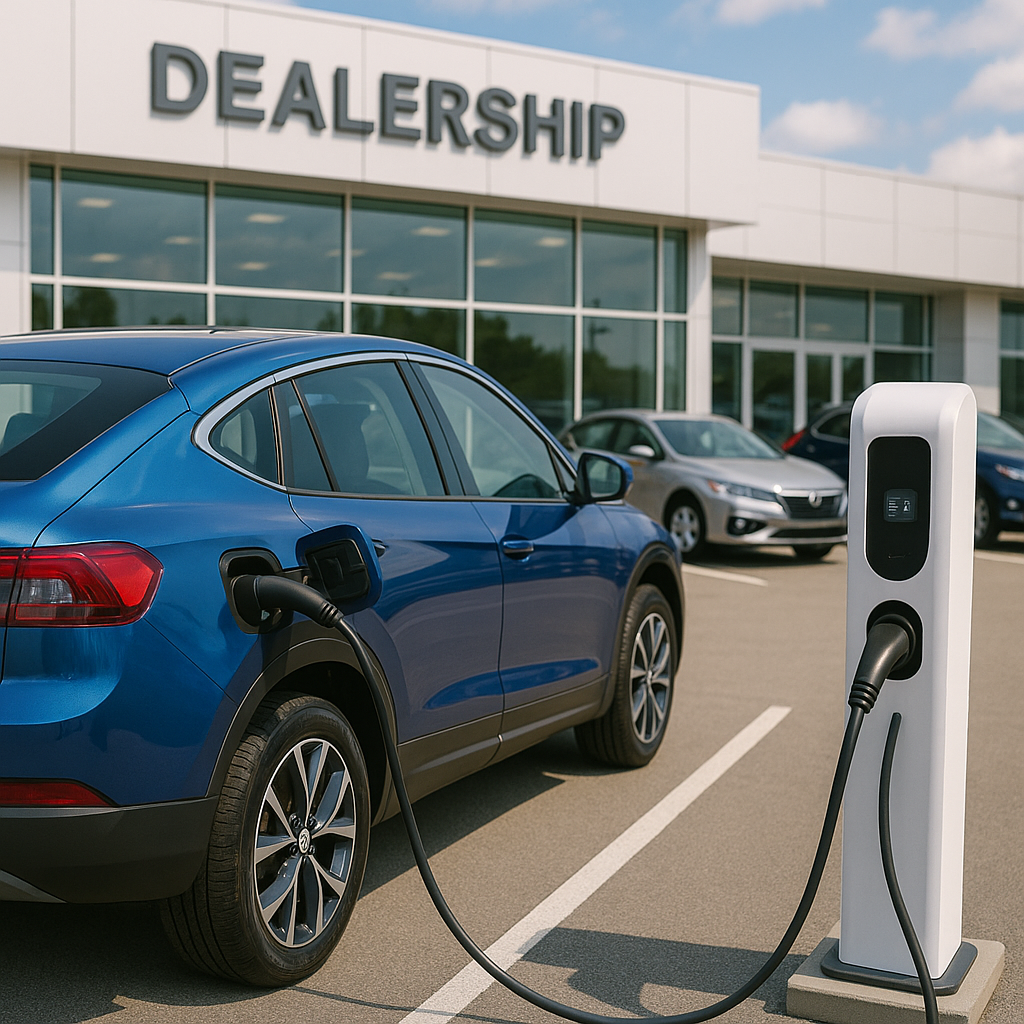Will NEVI Accelerate EV Adoption?

Experts believe electric vehicles (EVs) to be a high-impact solution to the emissions problems associated with traditional gasoline-powered automobiles. As such, with its potential to accelerate EV adoption rates in both commercial and consumer markets, the U.S. government’s National Electric Vehicle Infrastructure (NEVI) program has drawn particular attention.
NEVI can help address one of the major barriers to automotive electrification: a lack of a uniform EV charging infrastructure. Though consumers continue to adopt EVs at increasing rates, EV infrastructure varies widely by location. Some regions have excellent range and depth of coverage, while others have barely any at all.
In 2021, the U.S. government proposed an incentive-laden grant system to accelerate consumer engagement with electric vehicles. Specifically, the ambitious plan aimed to add 500,000 EV charging ports across the country. This represented a dramatic increase over the estimated 100,000 charging points that were active at the time.
The NEVI Formula Program is now the government’s signature funding package to meet these ambitious EV infrastructure development goals. This guide to eMobility development explores the NEVI program, its potential impacts, and technical details related to compliance.

A NEVI-Compliant Charging Network at a Glance
The National Electric Vehicle Infrastructure (NEVI) program emerged from the Biden administration’s bipartisan infrastructure bill. U.S. lawmakers passed the bill in late 2021, establishing a $5 billion fund for the rapid development of EV infrastructure across the country. The funding will cover a five-year period, beginning at the start of 2022 and running through the end of 2026.
Under the program, states qualify for proportional funding depending on their EV infrastructure development needs. The funding structure is known as the NEVI Formula Program. States received $615 million in funding in the 2022 fiscal year. Projections indicate that funding distributions for 2023 will total about $885 million.
To qualify for funding, states must build a charging infrastructure that complies with stringent National Electric Vehicle Infrastructure standards. Both technical and logistical elements apply to a NEVI-compliant EV charging network.
Technical Standards
To be NEVI-compliant, EV infrastructure must meet elevated technical standards in six main areas:
- Connectivity. A deep, detailed set of technical standards applies to NEVI charger-to-charger-network, charging-network-to-charging-network, and charging-network-to-grid connectivity, among other areas.
- Interoperability. Multiple standards guarantee the interoperability of charging networks. These primarily include ISO 15118 conformity and OCPP 2.0.1 compliance by 2025.
- Security. NEVI-compliant EV charging stations must have advanced cybersecurity features in areas such as user identity verifications, access controls, cryptography, software updating, monitoring, and incident response strategy.
- Communications. Under NEVI rules, charge point operators (CPOs) must supply an extensive set of identifying data and information to third-party software developers free of charge.
- Physical Features. The federal guidelines mandate that charging stations built with government funding must have at least four ports, Energy Star certification, and output voltages in the range of 250–920 DC, among other requirements.
- Technician Licensing and Certification. Electrical technicians who install, service, and operate the EV infrastructure must complete a government-backed or government-recognized training and certification program.
Customized open-source charge management software helps CPOs manage the connectivity, interoperability, security, and communication aspects of charging station operations with greater ease and efficiency. To this end, S44 has recently launched CitrineOS, an open-source charger network software for rapid OCPP 2.0.1 and NEVI-compliant EV charge management.
The user-friendly software was purpose-built for CPOs and manufacturers of EV charging infrastructure. S44 developed CitrineOS after spending nearly a decade developing custom software products for the electrification and eMobility verticals.
Logistical Standards
NEVI’s logistical requirements mainly intend to provide EV drivers with a secure, seamless, efficient, and fair charging experience. They cover:
- Station Availability. Stations situated along designated Alternative Fuel Corridors (AFCs) must have 24/7/365 availability. Those in off-AFC locations must remain fully available for public use during posted operating hours.
- Pricing and Payments. NEVI requirements include an extensive set of pricing transparency measures. For instance, they mandate that stations accept contactless payments from all major cards. Payment processing equipment must also be fully accessible to people with disabilities and people with limited proficiency in English.
- Data Protection. Government rules require CPOs to collect only strictly necessary data from customers. What’s more, proper safeguards must protect the collected data.
- Consumer Information. In addition to pricing, consumer information guidelines also cover charger availability, accessibility, fees, tariffs, and other key pieces of information.

Role of NEVI in the Campaign for EV Adoption
Theoretically, the NEVI funding program should function as a major catalyst for accelerating EV adoption rates. In fact, three particular aspects of the EV infrastructure program suggest it will give a major jolt to the ongoing push toward vehicle electrification:
A Mandate for Rapid Compliance
NEVI funding will remain available for five years, from fiscal year 2022 through 2026. This gives states a strong reason to make deep and prompt investments in developing their EV infrastructure without delay.
Moreover, federal funding can cover up to 80% of project costs. This creates a financial landscape that supports the government’s goal of making EV charging infrastructure as convenient and widely available as conventional gas stations.
Acceleration at the Consumer Level
EV adoption rates remain hampered by consumer uncertainties over certain practicalities of electrification, such as:
- “Range anxiety,” a term describing the worry that a driver’s vehicle charge will run out before they can reach a charging station
- Long battery charging times and the inconsistent availability of EV charging infrastructure
- A perception among consumers that EV charging infrastructure remains underdeveloped, despite significant recent improvements
NEVI was built to address all three of these concerns. In short, it aims to make EV infrastructure readily available at a national level. What’s more, through standardized protocols and advanced technologies that reduce charging times, owning an electric vehicle should become more practical, convenient, and affordable.
Strong Support and Incentives
NEVI covers up to four-fifths of the upfront infrastructure development costs. It also provides financing for the operation and maintenance of EV charging stations for up to five years after installation.
These program features stand to dramatically improve the commercial potential of operating a charging station. As a result, CPOs have strong incentives to participate in and adhere to NEVI compliance guidelines.

S44’s Open-Source EV Charging Management Software Supports NEVI Standards
The NEVI Formula Program appears poised to change the EV adoption game by addressing the most pressing pain points cited by both consumers and commercial fleet operators. Robust infrastructure is required to make mass-scale fleet electrification an attainable near-term prospect. NEVI is dramatically reshaping the playing field to that precise effect.
Notably, NEVI requirements mandate that all EV infrastructure built under the program must comply with OCPP 2.0.1 by 2024. After all, the OCPP standard is vitally important in the EV landscape. It ensures infrastructural interoperability while supporting a long list of strong and robust security, transparency, and convenience features.
S44 offers multiple tools to CPOs seeking to upgrade to NEVI compliance and better manage their transitions to OCPP 2.0.1 standards. In addition to the user-friendly CitrineOS platform, which users access through a single, easy app, S44 works with clients to build bespoke software solutions that incorporate CitrineOS as a foundational technology stack.
S44 also provides technology consulting and software development services to clients who lack in-house expertise in these areas. Get in touch with S44 today to learn more.







